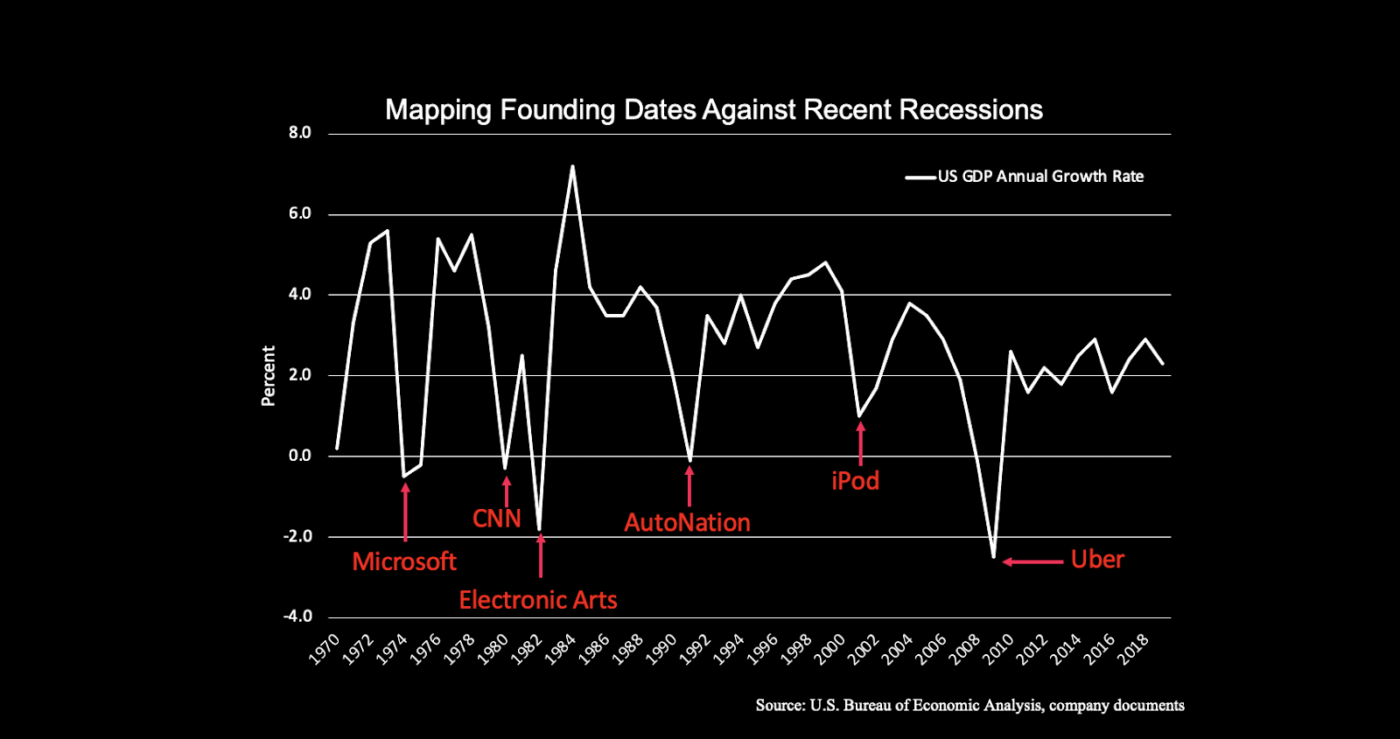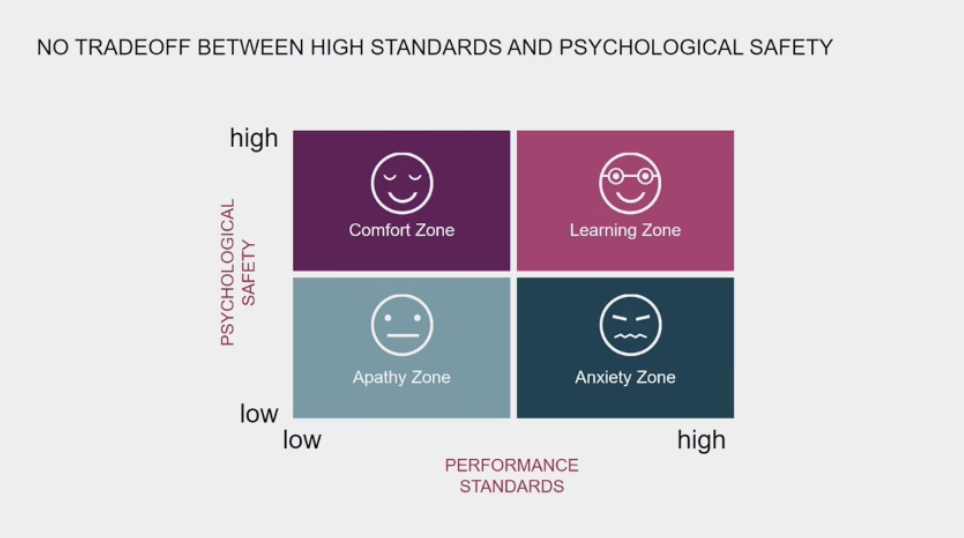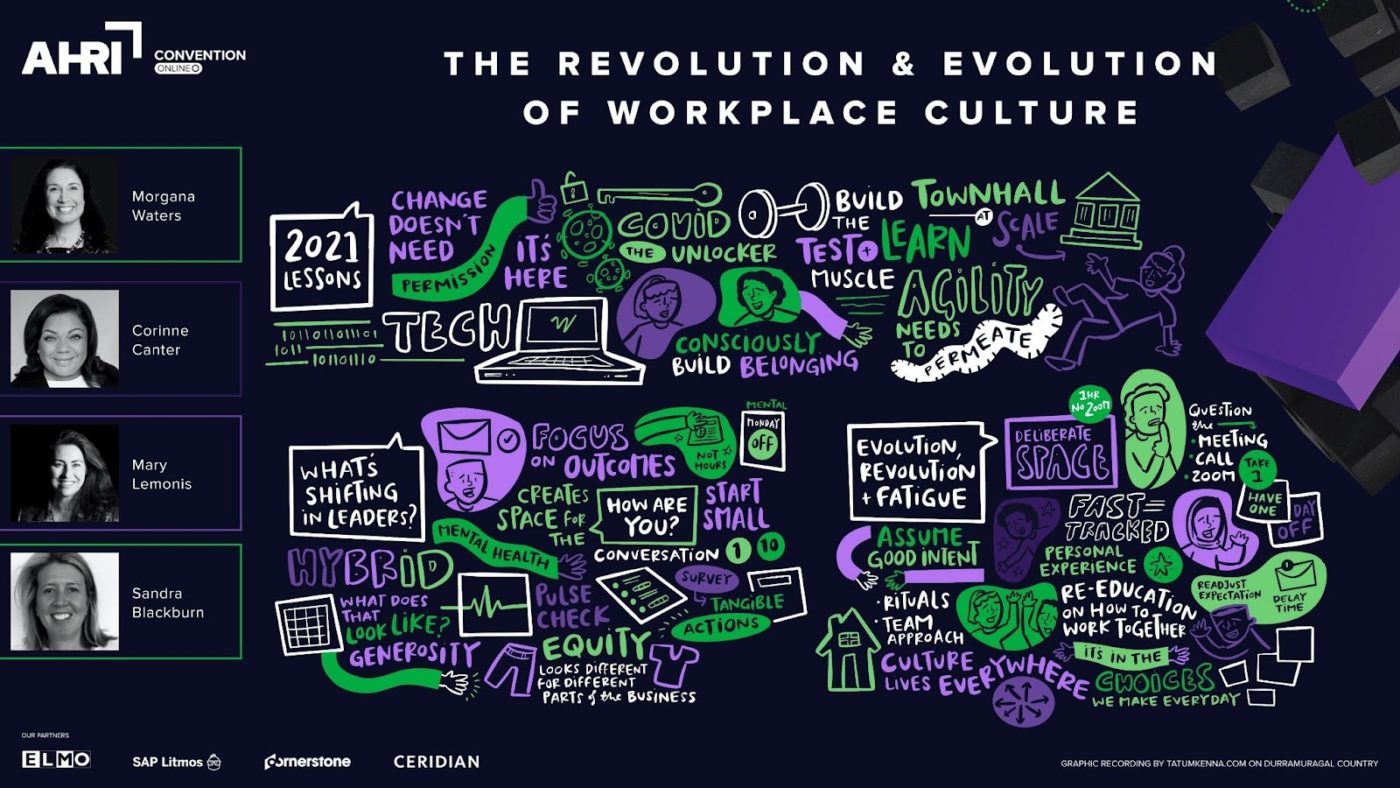The inspiring ideas were flowing at day two of AHRI’s Convention, TRANSFORM 2021. Speakers such as Charlene Li and Amy Edmondson left us with plenty of food for thought and actionable tips.
Workplace change of any kind can’t happen without HR taking a leading role in the transformation. That’s the key message to come out of day two of AHRI’s convention, TRANSFORM 2021. It doesn’t matter if it’s cultural change, digital change or procedural change. If it involves people, it should involve HR.
One speaker who encapsulated this message perfectly was disruption expert and New York Times best-selling author Charlene Li who got our creative juices flowing as the opening keynote for the day. Read more about her insights below.
If you’d like to skip to the section that interests you most, here’s what this article is covering:
- Charlene Li’s three-step process for thinking about workplace disruption.
- Psychological safety expert Amy Edmondson’s tips for creating inclusive leaders.
- Tips from a panel of experts on how to implement some of Edmondson’s tips.
- Some quick tips on enhancing culture in a remote environment.
Push yourself to the precipice
HR professionals need to take charge and push leaders, and themselves, outside of their comfort zones in order to be mavericks of the future, says Charlene Li.
Where should you begin? It starts with getting out of your own way, she said.
“So many companies don’t prepare themselves for disruption properly,” said Li. This could be about not knowing where to start, but Li says it’s more than that. Sometimes, you don’t have the right people in the room.
She conducted research which showed that only two per cent of HR professionals consider themselves as being influential when it comes to driving digital transformation in their workforces, placing the IT, finance, operations and marketing teams well above themselves.
“[Disruption] is not about technology. If anything, that’s the easy part,” says Li.

It’s employees, and the processes they’re wedded to, that’s the most challenging change point.
“And yet, so often the people who are most in tune with [employees], HR in particular, are missing from these discussions.”
Getting employees to buy into your transformation journey is about telling a story that makes sense to them – a sentiment shared by Jacqui Curtis in yesterday’s session. HR plays a pivotal role in helping employees to connect the dots between their hard work and what that can achieve – especially in times of crisis.
For example, Li shared a slide that shows the various business innovations that have come to life through crisis (see graph below) such as the development of Microsoft amid the 1970s oil crisis, or the introduction of the iPod during the 2000s dot.com bust.

“When huge amounts of change are happening, there are opportunities available for people to take advantage of.”
But how do you get there? Li suggests there are three focal points:
- See into the future
No, she didn’t suggest cracking out the crystal ball. Instead, she referred to a great metaphor from hockey sensation Wayne Gretzy who says to “skate to where the puck will be”.
“He trained himself to do this. He would watch hockey games on TV… and trace out the movements of the puck across the ice. He would analyse the situation, replay it in his head and, eventually, he got better and better.
“This is what organisations need to do. Anticipate what the future is going to look like, and take actions today. However difficult and uncertain the future may look, you need to make bets today.”
- Create a movement
This is about making sure everyone feels a sense of ownership over their work because then they’ll feel empowered, and they’ll understand their role in the bigger picture.
To help with this, senior leaders should determine employees’ disruption appetite because this will help them identify those who might be the least inclined to change. As Li says, “you can only go as fast as your slowest worried sceptic.”
- Build a flux culture
This aligns closely with psychologically safe workplaces (more on that below) as it’s about openness, agency and a basis for action.
These cultures create a space to feel comfortable reacting quickly to situations and “failing fast”.
“The fact is, 99 per cent of the decisions we make are reversible. Yet we act as if they’re all irreversible decisions because the idea of going backwards is not possible [in our minds],” she says.
“In order to take on a disruption mindset, you have to move out of your comfort zone. Take your organisation to the very edge of that comfort zone… [then] create the scaffolding of trust, so you know you’re [safe] together at the very edge, experiencing the thrill of creating that change.”
Developing inclusive, psychologically safe leaders
Amy Edmondson, Novartis Professor of Leadership at Harvard Business School, is the leading expert on psychological safety. You may have heard these two words pop up more often in recent months and that’s because, according to her, psychological safety has suffered in our remote work environments.
“It’s hard to feel that our voices matter when your colleagues are distal and you’re reduced to a little Post-It-sized [image] on someone’s computer screen,” she said.
Edmondson started her talk with a very important note about a common misconception – psychological safety is not about being nice, or getting a round of applause for all your ideas. Quite the opposite, in fact.
“When we have a very psychologically safe environment, there’s more debate and more dissent,” she says.
(Want to learn more about what psychological safety at work is all about? Read HRM’s previous interview with Edmondson here).
“It’s hard to feel that our voices matter when your colleagues are distal and you’re reduced to a little Post-It-sized [image] on someone’s computer screen.” – Amy Edmondson.
Psychological safety isn’t just within the purview of senior management either. In fact, middle management plays an important role because psychological safety doesn’t occur on an organisational scale. It happens within teams.
“It’s those leaders in the middle who shape the interpersonal climate.”
For this reason, Edmondson says we need inclusive leadership capabilities at all levels of the organisation. This leadership style boils down to a few simple concepts. But, as Edmondson suggests, simple doesn’t always mean easy.
1. How do you frame near misses?
Are they treated as a failure or as a learning experience?
If the message is delivered in a threatening way – i.e. a blame game – people are less likely to report issues in the future because “proximity to harm makes near misses more threatening and thus more difficult to raise”.
Since psychological safety is about encouraging candour and for people to speak up, anything that silences employees needs to be eliminated.
2. Keep standards high
To Edmondson’s earlier point around psychological safety not about being nice, it’s important that leaders continue to challenge people to perform to their highest standard. Psychological safety and high performance are not diametrically opposed.

As the image above indicates, when employees feel psychologically safe but performance standards are low, they’re not innovating or pushing themselves. They’re dwelling in what Edmondson calls the ‘comfort zone’.
However, if performance standards are high but psychological safety is low – the anxiety zone – employees can work themselves into a state of burnout, feeling as if they cannot speak up, challenge others or ask for help.
You want to find that sweet spot where employees can be challenged in a safe way. The bar is high and they feel they can ‘fail fast’. This leads nicely into Edmondson’s third point.
3. Understand the three different types of failure
To get into the learning zone, employers need to reconsider how they think and talk about failure. Edmondson believes there are three types:
- Simple – when the right steps aren’t followed.
- Complex – when multiple factors combine in novel ways resulting in a failure.
- Intelligent – an undesirable result that occurs when trialling something new.
An intelligent failure is something we can learn from.
“It’s in pursuit of an opportunity… There’s some possible product or improvement opportunity. It is hypothesis-driven, meaning you’ve taken the time to think through what you know and what you don’t know,” she said.
For example, let’s say you trial a new engagement initiative, but it doesn’t land well with your employees. You can seek feedback, look to other organisations that have got it right, then tweak the process and try again with an improved version.
4. Ask good questions
“A good question is one that helps us appropriately focus on an issue that matters. [It’s one] that indicates you really want to hear the person’s thoughts, and gives them room to respond,” said Edmondson.
That might be asking, ‘What are we missing? Who has a different view? How do our competitors think about this?’
They’re also questions that dive deeper, like, ‘Can you give me an example?’ or ‘What might happen if XYZ.’
These questions need to be asked at a leadership and employee level.
5. Respond productively
Finally, leaders need to learn how to respond to ‘bad’ news effectively.
Edmondson shared an anecdote to demonstrate this in action. It was about an executive who had to tell the CEO that a serious production issue was going to lead them to lose $17 billion that year. That’s devastating news, but the CEO responded exactly as he should have.
“He said, ‘Thank you for that clear line of sight’,” she said. “If you want to be productive, the emphasis must stay on the future [and solutions].”
Edmondson knows these aren’t easy steps to implement, so she encouraged the audience to ask themselves which areas they find the hardest and start there. Is it asking good questions or responding productively? Or perhaps it’s learning how to reframe your near misses in a positive light.
If you want to check the state of psychological safety in your organisation, you can use this free tool from Edmondson’s Fearless Organisation website.

Putting it into practice
Actioning Edmondson’s insights is no easy feat, but a dynamic breakout session after her talk, chaired by psychologist and Co-Founder of The Wellbeing Lab, Danielle Jacobs, helped equip HR practitioners with actionable steps to take back to their organisations. Here’s a taste of what they discussed.
- Find your canary thresholds – Fiona Michel FCPHR, AHRI board member and Chief People Officer at Vector, spoke about what she called the “canary thresholds”.
Too often leaders rely on lag indicators, such as engagement surveys, which don’t help leaders to preempt issues. Instead, they need the equivalent of ‘a canary in the coal mine’ to immediately alert them when something is wrong.
“We have to think about what we would see, feel or hear before we have an issue, [verses] what would we see, feel and hear when we’re having an issue,” said Michel.
- Model psychologically safe behaviour – Organisational psychologist Dr Paige Williams echoed Edmondson’s comments about middle managers being the gatekeepers of psychological safety. However, she added that executives need to model it.
“Get [senior leaders] to tell stories about when they’ve been at their best, and then identify how psychological safety [got] them there,” says Williams.
- Use your data wisely – Penny Lovett FCPHR, Chief Human Resources Officer at the Salvation Army, encouraged HR to use multiple data points to assess areas where psychological safety could be bolstered.
“You might get some insights around your customer feedback information… then line that up with some of your injury rates [or] hazard reporting. There are a whole lot of things you can look at that might give you some insight around where you might have hotspots.”
Enhancing a remote culture
Towards the tail-end of the day, we were able to sit on the fringes of a fascinating conversation between Corinne Canter, Head of Consulting at Human Synergistics Australia, and three HR experts.
The theme of the conversation was ‘the revolution and evolution of workplace culture’ and the panelists shared a range of interesting tips that they’ve been implementing in their workplaces, such as:
- Give people a break
Sandra Blackburn, Group GM Human Resources at Hanes Australasia, lit up the discussion panel when she started talking about offering what she called ‘Mental Health Monday’ – a surprise day off for employees to look after their mental health.
“We’ve had emails coming in saying things like, ‘I cried when I heard about this’. It’s a symbol that the organisation really cares about their mental health.”
In the comment section, delegates quickly shared similar initiatives from their own workplaces, such as Feel Good Days, Me-Time Monday and COVID Relief Day.
Chief People Officer Mary Lemonis said REA Group offers something similar. It has recently implemented ‘Zoom free time’ to help employees get into the deep work zone each day, and a ‘Give one, Get One’ initiative whereby employees who take a day of leave are rewarded by getting another day in return.
“We also took the cap off personal leave,” said Lemonis. “Yes, there was a bit of a spike [in uptake], but it wasn’t insane. People used it prudently and judiciously. It’s such a good reminder that we can get caught up in the exceptions and the ‘what ifs’… but we’ve got to play to the highest common denominator.”
- Embracing peer-to-peer learning
Morgana Waters, GM of Organisational Development and Employee Experience at QBE Insurance, talked about what QBE calls ‘Professor Fridays’ where one of their employees in the data and analytics team (the ‘Professor’) spends two hours every second Friday solving a business problem with those on the video call.
“Rather than ‘death by slides’ – because we’re all getting a bit over digital learning – it’s helping people to build that [leadership] muscle. It’s not just resorting to drinking on a Friday and wearing a silly hat like we did in 2020.”
- Connecting for the sake of connection
Leaders need to remember that it’s not always about getting straight down to business, said Blackburn. When you ask someone how they’re doing, ask them twice, she suggests, so they know you really want a genuine answer.
Lemonis seconded this and said never rush a wellbeing conversation. She sets aside around 90 minutes to have these talks with employees. You don’t want to give them the impression you have something more important to rush off to.

This is a sliver of the takeaways from Thursday’s session. This article could have easily been twice, maybe three times, as long. We’ll have the final wrap-up ready for your inboxes on Monday morning. Until then, share your favourite parts of the convention in the comment section.


Great article. Very true about low safety/low performance leading to apathy zone.
A great article which summarises and gives perspective really well. One of the biggest learnings in my career has been about Psychological Safety and it being a foundation to having a really good team or workplace environment. And how the absence of it allows toxic environments to thrive. I look to incorporate this as a foundation into the work that I do, and the difference it can make is remarkable. Good performance comes from good foundations and environments. It’s great that you’re helping us all know about it more, and hopefully keep applying it more in the organisations we influence.… Read more »